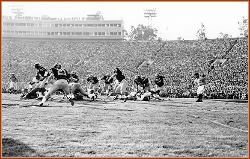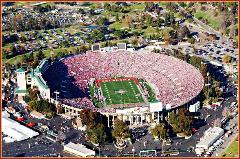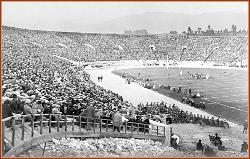




Lane Stadium/Worsham Field is a stadium located in Blacksburg, Virginia. It is the home
field of the Virginia Tech (VT) Hokies, a football team. It was rated as the "number one
home field advantage" in all of college football in 2005 by Rivals.com.
In 1963, Stuart K. Cassell, namesake of Cassell Coliseum and a former school
administrator, proposed building a larger stadium to replace Miles Stadium, a 17,000-seat
stadium. Construction of Lane Stadium began in April 1964. It took a total of four years to
complete construction. However, the first game in the new stadium was played in 1965,
when VT beat William & Mary 9-7. At the game, only the west stands and center section of
the east bleachers were completed. It wasn't until the summer of 1968 that construction
was completed on Lane Stadium. It officially cost of $3.5 million. This brand new stadium
seated 35,050 and featured a press box for guests, writers and stats crew-members, and
scouts and coaches.
The stadium is named after Edward H. Lane, a graduate of the university and a former
member of the Board of Visitors. Lane headed an educational foundation project which
raised over $3 million for the original construction. Like many stadiums built at the time,
the original stadium consisted of two bowed sideline grandstands and endzone bleachers.
Lane Stadium saw a calm first 20 years, but in the Eighties the stadium started expanding
and updating technology that has lasted until 2005. The year 1980 saw the expansion of
the west stands to increase the capacity to 52,500. Two years later, the Stadium installed
a brand-new lighting system that would help the team get its first nationally broadcast
game on WTBS. The game was a 21-14 win over state rival University of Virginia.
Before the 1989 season began, the Stadium received 16 flags to adorn the stadium. It
also got a new paint job, which included the maroon and orange stripes inside the
stadium.

On September 5, 1992, Worsham Field was dedicated in honor of Wes and Janet Worsham, longtime Hokie supporters from Kilmarnock, Virginia.
The Worshams pledged $1 million to the university's Second Century Campaign. The Campaign raised over $18.6 million -- $1.7 million more
than the original goal.
In the spring of 1994, renovations were completed on seven lower sections of the east stands. Renovations also included replacing concrete
risers and the addition of wheelchair seating. Also, before the 1994 season, plaques bearing retired jerseys of Tech heroes Bruce Smith, Carroll
Dale, the late Frank Loria and Jim Pyne were added to the wall in the north end zone. However, with the later addition of the north end zone
seats, the four retired numbers now fly on flag poles above those stands.
Before the start of the 1998 season, the oldest bleachers were replaced with new locust wood and the stands were waterproofed. On the east
side, the roof on the old visitors' locker room was replaced along with the bleachers above the dressing room.
Before the 1999 season, the university started work on the north end zone. The summer of 1999 saw the addition of roughly 2,100 seats to the
north end zone. In the summer of 2000, 3,000 more permanent bleacher seats were added to the north end zone. That summer also saw the
addition of a new scoreboard, Hokievision. It was installed behind the north end zone. The summer of 2001 saw the latest round of additions to
north end zone bleachers - 600 seats for The Marching Virginians. In total, these moves made the capacity to 53,662.
Prior to the 2002 season, the stadium saw 11,120 seats added in the south end zone to effectively enclose that end of the stadium. The double-
deck structure is similar to that of the Cleveland Browns' "Dawg Pound" section. It has bleacher, bench-back and club seats. The structure is
enclosed, but has gaps between the older structures and itself. This is the result of building codes and a desire to get fans even closer to the
field.
Perhaps the biggest addition to Lane Stadium was completed prior to the 2006 season. After the 2004 season, the old press box was removed
and construction began on this west-side expansion, filling in to match what was built up during the 2004 season. The new boxes include a new
press area, on the side toward the south end zone, with a dining area and improved facilities. Also, the fencing that surrounds the stadium was
removed, and the area on the west side exterior of the stadium landscaped with walkways and a weekday parking lot for ticket patrons and Hall of
Fame and Hokie Club visitors. New luxury suites, President's area, four private club seating areas, concession stands, ticket office, athletic fund
offices, an Athletics Hall of Fame and student academic services area were also included in this latest project. A two tier grandstand featuring
11,000 seats, 15 luxury suites, and a new visitor’s locker room was completed. The $52.5 million expansion includes 23 luxury suites, a new
pressbox, and club seating. The addition increased Lane Stadium's seating capacity to 66,233.
The 2005 season also sees new addition to playing field. Hokie Stone now ordains the walls of each end zone. This goes with the outside of most
of the university's buildings. New kicking nets have also been installed in both end zones. A new video screen - 1/3 larger - has replaced the old
one. New lights that will double the amount of light and reduce shadows on the field were added as part of the renovation too. The traditional
"Home of the Fighting Gobblers" sign was also removed from the West Stands during this renovation.






